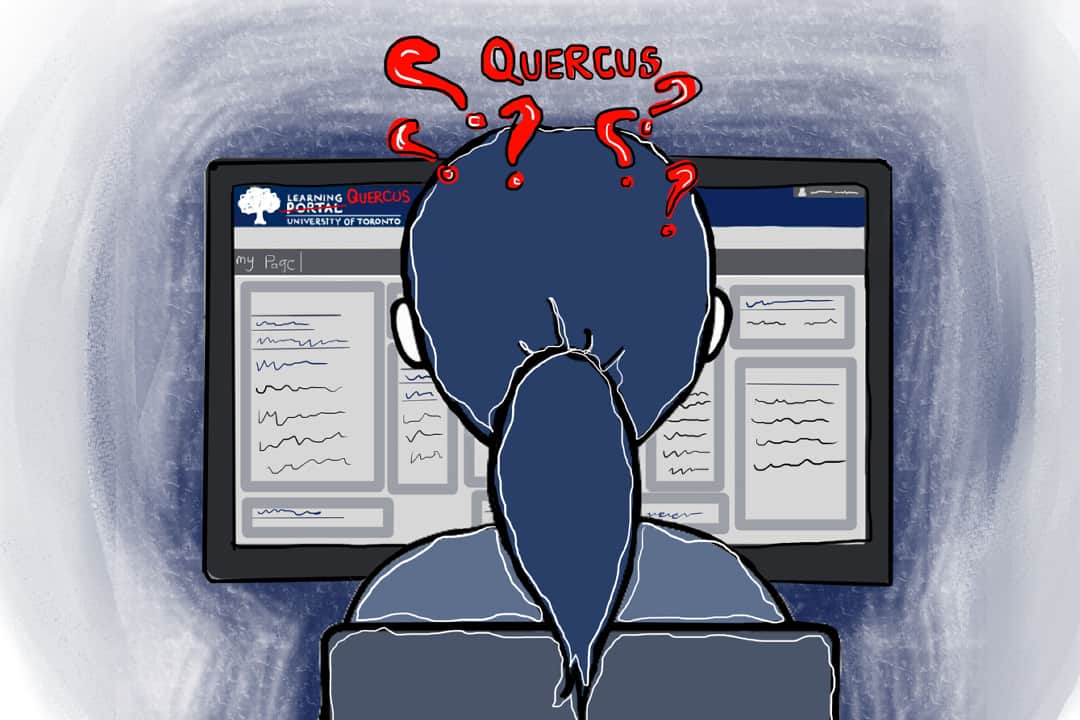Have you ever wondered what your professors can see about your activity on Quercus? With most classes taking place online this year, professors may be using the learning management system more than ever for basic course functions like quizzes or discussion boards.
With final exams starting up and the semester coming to a close, The Varsity breaks down what exactly your professors can see about your Quercus usage — which, as it turns out, is a lot — and how they might use it.
Course-wide data
Professors have access to a host of data about course participation as a whole, including an interactive graph of weekly average number of pages viewed by all students, as well as the average online participation in the course between all students.
Average participation is calculated by taking into account any actions on the Quercus page, including posting a comment to an announcement or discussion, submitting an assignment, submitting a quiz, and starting a quiz. Quercus also shows when students participated in the course or opened a course page, as well as how many times any single page has been viewed.
Professors can view charts of assignment submission data, which show what percentage of students have submitted an assignment over time. They can also view graphs of all of the grades given for a specific assignment.
Individual data
For each individual student, professors can see all page views and participation in the course, as well as a thorough access report of when the student last viewed a certain page and how many times they participated in discussions or submitted an assignment.
Quercus also provides a list of the content items that a student viewed in the course, as well as the number of times they viewed the content; a view is recorded each time the student navigates to the URL or downloads an attachment.
Professors who have modules with requirements and prerequisites are able to track a student’s progress as they move through the module, which means when students view a page, submit the required assignment, or pass a quiz. Progress will be shown as completed, in progress, or locked.
Quercus also provides a “student context card” for each individual student, showing their current mark, the number of missing and late assignments, and their mark on the last 10 graded assignments.
It also shows their participation and page views out of three stars, as compared with other students in the class. Zero stars indicate no participation, one star indicates low participation, two stars indicates moderate participation, and three stars indicates high participation.
Quiz logs
Quercus allows professors to see extremely thorough data about quizzes, providing a quiz log for each student. According to a U of T webpage, quiz logs are meant to “investigate problems that a student may have in a quiz and see the status of student quizzes.”
The quiz log shows a timestamp for when the student started the quiz, when they attempted it an additional time, when and for how long they viewed a question, and when they answered a question. The log gives timestamps for if and when the student stops viewing the quiz for more than 15 seconds — if the student is inactive or has moved to a different tab, window, or course page — and when the student resumes the quiz.
How do professors use these functions?
With extensive data available on student activity on Quercus, professors may use the available data in a variety of ways.
Alexandra Guerson, a lecturer currently teaching HIS101 — Histories of Violence, and IFP100 — Themes in World History at New College, tries to avoid using all of the information accessible to her as an instructor.
“Since I have not communicated to students what kind of data Quercus collects and that I would be using it, I don’t feel it ethical for me to access that data,” wrote Guerson in an email to The Varsity. Guerson expressed that she generally does not use Quercus analytics like usage data or quiz logs. However, she noted a few exceptions when she did opt to use them.
In the past, she has viewed quiz statistics to see the average number of attempts that students made on quizzes with unlimited attempts, though she noted that this year she has limited the number of attempts and therefore does not look at that data anymore.
She also used Quercus usage statistics at the beginning of the semester to see which students had not logged in yet. As a professor for a first-year course, she wrote that she did this to ensure that all students were able to successfully log in to Quercus, contacting those who had not.
The Varsity has reached out to U of T Media Relations for comment.


